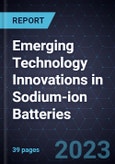A Lower Levelized Cost of Storage and Enhanced Safety Characteristics Drive Sodium-ion Batteries Toward Successful Commercialization
The world requires more energy storage solutions for a vast range of applications - electric mobility, on-grid and off-grid stationary energy storage, consumer electronics, and data centers, among others. Lithium-ion batteries, currently the most widespread energy storage technology, face many issues that novel energy storage technologies must overcome as energy demand grows. These issues include a growing strain on the supply chain as demand rises exponentially, issues with mining the metals used in them (nickel and cobalt), safety issues, and high costs.
Sodium-ion batteries provide an attractive value proposition as they can potentially overcome said challenges. Their manufacturing uses abundant materials - such as sodium and aluminum - which are unlikely to suffer from supply chain disruptions and are often locally available, thus supporting local manufacturing. This is a growing concern across the globe as the Russo-Ukrainian War and the China-Taiwan conflict disrupt markets. Moreover, sodium-ion batteries are safer than lithium-ion ones, as they are less prone to thermal runaway and can work in a wider ambient temperature range.
Sodium-ion batteries’ working mechanism is analogous to that of lithium-ion ones since they belong to the same family of alkali metals and share similar chemical properties. With some modifications, current production facilities can manufacture sodium-ion batteries, thus enabling manufacturing to scale up rapidly.
This report describes the technology landscape of sodium-ion batteries, their working mechanism and typical materials used for manufacturing; growth drivers and restraints; and a comparative analysis versus lithium-ion, lithium-sulfur, vanadium redox flow, and metal-air batteries according to standard parameters - energy density, cost, and round trip efficiency, among others. Finally, this study includes an analysis of the technology’s company innovation landscape, its patent landscape, and detailed growth opportunity analysis and calls to action that will be key enablers for its adoption.
Table of Contents
Companies Mentioned (Partial List)
A selection of companies mentioned in this report includes, but is not limited to:
- Natron Energy
- Faradion








